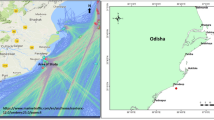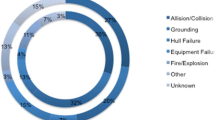Abstract
Both deterministic and probabilistic strategies are employed in numerical oil spill model to estimate potential oil spill risk. The deterministic model simulates transport and weathering processes by means of a particle tracking method. While a Monte Carlo stochastic simulation approach is run for multiple scenarios, spill size, oil type, and environmental conditions (meteorological and hydrological data) combinations, to characterize the consequences of spills for a specified potential spill location. The statistically-defined oil spill map does not demonstrate the probabilities of oil-slick presence for each grid area, but also provide the information of the shortest arrival time which is quite vital for oil contingency plan.
Access this chapter
Tax calculation will be finalised at checkout
Purchases are for personal use only
Similar content being viewed by others
References
ASCE, Task Committee.: State-of-the-art review of modeling transport and fate of oil spills. J. Hydraul. Eng. 122, 594–609 (1996)
Azevedo, A., Oliveira, A., Fortunato, A.B., Zhang, J., Baptista, A.M.: A cross-scale numerical modeling system for management support of oil spill accidents. Mar. Pollut. Bull. 80, 132–147 (2014)
Blumberg, A.F., Mellor, G.L.: A description of a three-dimensional coastal ocean circulation model. In: Heaps, N. (ed.) Three-Dimensional Coastal Ocean Models, vol. 4, pp. 1–16. AGU, Washington (1987)
Booij, N., Ris, R.C., Holthuijsen, L.H.: A third generation wave model for coastal regions, part I: model description and validation. J. Geophys. Res. 104(C4), 7649–7666 (1999)
Chao, X., Shankar, N.J., Wang, S.S.Y.: Development and application of oil spill model for Singapore coastal waters. J. Hydraul. Eng. 129, 495–503 (2011)
Chen, C., Liu, H., Beardsley, R.C.: An unstructured grid, finite-volume three-dimensional, primitive equations ocean model: application to coastal ocean and estuaries. J. Atmos. Ocean. Technol. 20, 159–186 (2003)
Frazão Santos, C., Carvalho, R., Andrade, F.: Quantitative assessment of the differential coastal vulnerability associated to oil spills. J. Coast. Conserv. 17, 25–36 (2013)
Guo, W.J., Wang, Y.X.: A numerical oil spill model based on a hybrid method. Mar. Pollut. Bull. 58, 726–734 (2009)
Guo, W., Hao, Y., Zhang, L., Xu, T., Ren, X., Cao, F., Wang, S.: Development and application of an oil spill model with wavecurrent interactions in coastal areas. Mar. Pollut. Bull. 84, 212–224 (2014)
Mariano, A.J., Kourafalou, V.H., Srinivasan, A., Kang, H., Halliwell, G.R., Ryan, E.H., Rofferc, M.: On the modeling of the 2010 Gulf of Mexico oil spill. Dyn. Atmos. Oceans 52, 322–340 (2011)
Marta-Almeida, M., Ruiz-Villarreal, M., Pereira, J., Otero, P., Cirano, M., Zhang, X., Hetland, R.D.: Efficient tools for marine operational forecast and oil spill tracking. Mar. Pollut. Bull. 71, 139–151 (2013)
Mellor, G.L.: The depth-dependent current and wave interaction equations: a revision. J. Phys. Oceanogr. 38, 2587–2596 (2008)
Reed, M., Johansen, Ø., Brandvik, P.J., Daling, P., Lewis, A., Fiocco, R., Mackay, D., Prentki, R.: Oil spill modeling towards the close of the 20th century: overview of the state of the art. Spill Sci. Technol. Bull. 5, 3–16 (1999)
Shchepetkin, A.F., McWilliams, J.C.: The regional oceanic modeling system (ROMS): a split-explicit, free-surface, topography-following-coordinate oceanic model. Ocean Model. 9, 347–404 (2005)
Stiver, W., Mackay, D.: Evaporation rate of spills of hydrocarbons and petroleum mixtures. Environ. Sci. Technol. 18, 834–840 (1984)
Tkalich, P., Chan, E.S.: Vertical mixing of oil droplets by breaking waves. Mar. Pollut. Bull. 44, 1219–1229 (2003)
Zhang, Y., Baptista, A.M., Myers, E.P.: A cross-scale model for 3D baroclinic circulation in estuary-plume-shelf systems: I. Formulation and skill assessment. Cont. Shelf Res. 24, 2187–2214 (2004)
Zhang, Y., Baptista, A.M.: SELFE: a semi-implicit Eulerian-Lagrangian finite-element model for cross-scale ocean circulation. Ocean Model. 21, 71–96 (2008)
Acknowledgments
The work described here would not have been possible without the efforts of my colleagues and students, including Li Zhang, Hui Liu, Yanni Hao, Yan Zou and Qi Guo. This work is sponsored by the Ministry of Transport of China under No. 2013 329 225 240, the Fundamental Research Funds for the Central Universities (2012QN059) and National Natural Science Foundation of China (No. 41206095, No. 51409037).
Author information
Authors and Affiliations
Corresponding author
Editor information
Editors and Affiliations
Rights and permissions
Copyright information
© 2015 Springer International Publishing Switzerland
About this chapter
Cite this chapter
Guo, W., Xu, T. (2015). Application of a Numerical Statistical Model to Estimate Potential Oil Spill Risk. In: Ehrhardt, M. (eds) Mathematical Modelling and Numerical Simulation of Oil Pollution Problems. The Reacting Atmosphere, vol 2. Springer, Cham. https://doi.org/10.1007/978-3-319-16459-5_6
Download citation
DOI: https://doi.org/10.1007/978-3-319-16459-5_6
Published:
Publisher Name: Springer, Cham
Print ISBN: 978-3-319-16458-8
Online ISBN: 978-3-319-16459-5
eBook Packages: Mathematics and StatisticsMathematics and Statistics (R0)




